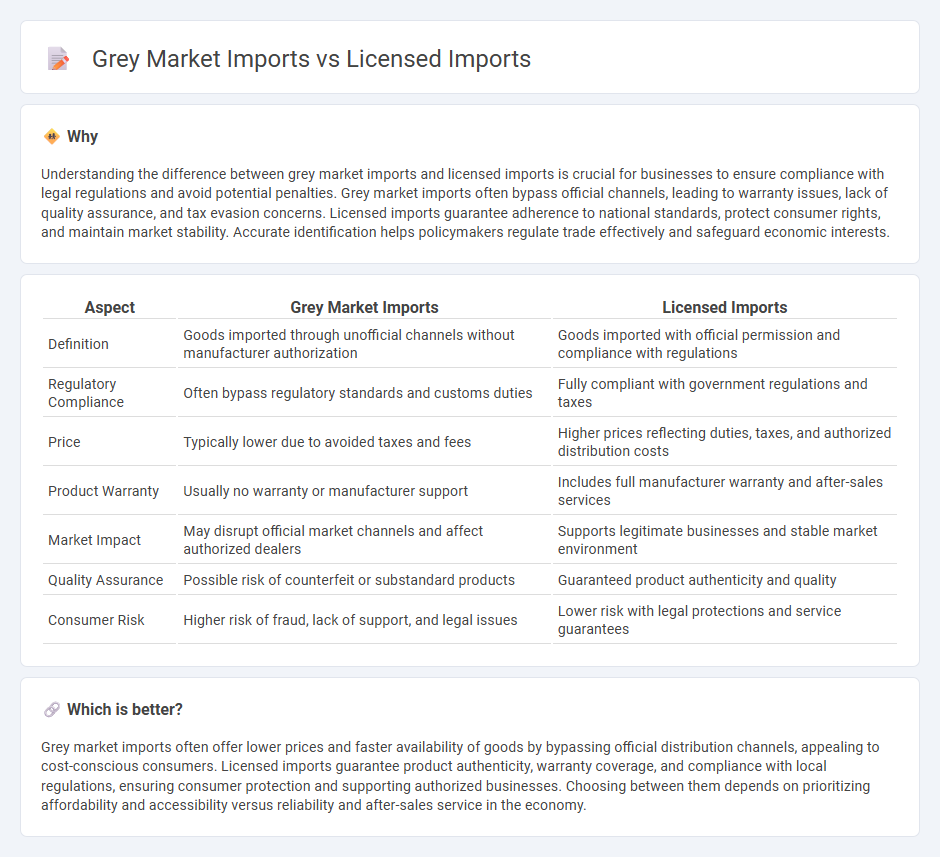
Grey market imports occur when products are brought into a country through unauthorized channels, often bypassing official distribution networks and regulatory oversight. Licensed imports involve goods imported with government approval, ensuring adherence to standards, tariffs, and taxes, which supports domestic industries and consumer protection. Explore further to understand the economic impacts and regulatory frameworks differentiating these two import channels.
Why it is important
Understanding the difference between grey market imports and licensed imports is crucial for businesses to ensure compliance with legal regulations and avoid potential penalties. Grey market imports often bypass official channels, leading to warranty issues, lack of quality assurance, and tax evasion concerns. Licensed imports guarantee adherence to national standards, protect consumer rights, and maintain market stability. Accurate identification helps policymakers regulate trade effectively and safeguard economic interests.
Comparison Table
| Aspect | Grey Market Imports | Licensed Imports |
|---|---|---|
| Definition | Goods imported through unofficial channels without manufacturer authorization | Goods imported with official permission and compliance with regulations |
| Regulatory Compliance | Often bypass regulatory standards and customs duties | Fully compliant with government regulations and taxes |
| Price | Typically lower due to avoided taxes and fees | Higher prices reflecting duties, taxes, and authorized distribution costs |
| Product Warranty | Usually no warranty or manufacturer support | Includes full manufacturer warranty and after-sales services |
| Market Impact | May disrupt official market channels and affect authorized dealers | Supports legitimate businesses and stable market environment |
| Quality Assurance | Possible risk of counterfeit or substandard products | Guaranteed product authenticity and quality |
| Consumer Risk | Higher risk of fraud, lack of support, and legal issues | Lower risk with legal protections and service guarantees |
Which is better?
Grey market imports often offer lower prices and faster availability of goods by bypassing official distribution channels, appealing to cost-conscious consumers. Licensed imports guarantee product authenticity, warranty coverage, and compliance with local regulations, ensuring consumer protection and supporting authorized businesses. Choosing between them depends on prioritizing affordability and accessibility versus reliability and after-sales service in the economy.
Connection
Grey market imports and licensed imports intersect through the supply chain dynamics affecting product availability and pricing. Grey market imports involve goods brought into a country without the manufacturer's authorization, often leading to price disparities that impact licensed importers who operate within regulated frameworks. The coexistence of both import channels influences market competition, consumer choice, and regulatory oversight in the economy.
Key Terms
Intellectual property rights
Licensed imports ensure authorized distribution by complying with intellectual property rights, protecting brand integrity and preventing counterfeit products. Grey market imports bypass official channels, often infringing on trademarks and copyrights, leading to potential legal disputes and diminished brand value. Explore how intellectual property enforcement shapes the dynamics between licensed and grey market imports.
Parallel imports
Parallel imports refer to genuine products imported through unauthorized channels, often sold at lower prices than licensed imports, which are officially sanctioned by brand owners or manufacturers. Licensed imports guarantee product authenticity and warranty support, while parallel imports may lack these benefits yet offer competitive pricing for consumers seeking access to international goods. Explore the nuances, regulations, and impacts of parallel imports to better understand their role in global trade.
Regulatory compliance
Licensed imports strictly adhere to government regulations, including customs duties, quality standards, and intellectual property rights, ensuring legal distribution within the market. Grey market imports bypass official channels, often lacking regulatory compliance, which can lead to potential risks such as counterfeit products and warranty voidance. Explore more about the impact of regulatory compliance on market dynamics and consumer protection.
Source and External Links
Import Licensing - WTO Issues - Import licensing systems require an application or documentation before importation, covering both automatic monitoring and non-automatic licensing for restrictions, quotas, or safety regulations, administered under WTO rules to ensure fairness and prevent unreasonable delays.
How to get an import license or permit - In the U.S., most goods do not need an import license, but certain regulated items require permits from federal agencies with specific applications and procedures that importers must follow.
Import license - An import license is a government-issued authorization for importing specific goods, often used as a non-tariff barrier to control or limit imports to protect domestic industries, specifying quotas and sometimes involving political or economic considerations.
 dowidth.com
dowidth.com